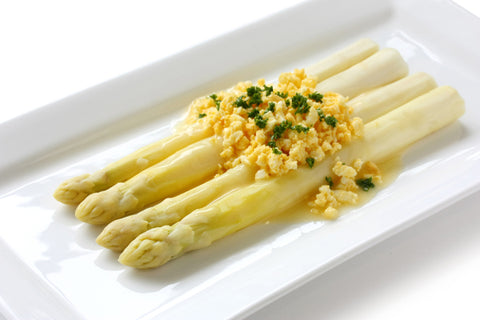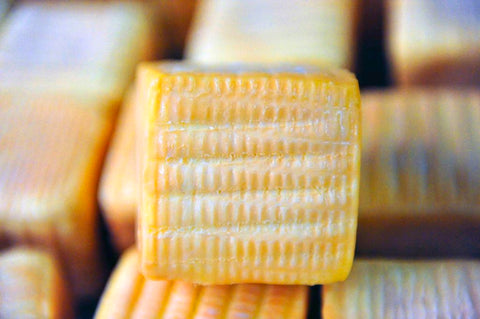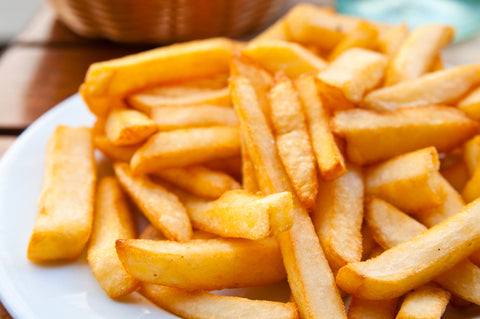- No products in the cart.
Belgian Specialities
We are so used to quality food in Belgium that it is often taken for granted. It is of course when we travel abroad that we really start to miss our local specialities. Nothing tastes as good as our home made jam from freshly picked strawberries, cherries or rhubarb with a touch of sourness.
Looking for sausage? Specify exactly what you want at the butcher's. You will surely leave the shop with some local variety such as the ‘boudin blanc’ (white sausage) or ‘boudin noir’ (black sausage) from the city of Liège.
The Dutch expression ‘eenheidsworst’ says the opposite: ‘exactly the same all over’.
From the coast of Flanders to the forests of Wallonia, local products made with local produce have become increasingly popular over the past few years.
We invite you to explore our ‘terroir’, look for specialities in rural areas and in each city. Sweet, sour, bitter or salty, there is always something to discover.
Every village, town or city claims to have some, even if they have been recently re-discovered. We would rather stick to those with a strong local tradition and hope you enjoy our selection.
Belgian Fries

Chips, fries or frieten/frites as the Belgian’s call them are a national culinary icon. Here’s the secret. Take a large potato, preferably a floury variety such as a Bintje or else an Agria, Désirée, Première, Rode Eersteling or Santé. Peel the potato and cut it into strips of equal length – as thick or thin as you like.
Rinse the raw potato strips with cold water to remove the starch, and dry them using a cloth. Pre-cook them in a deep-fat fryer for about five minutes at a temperature of circa 150° C /300°F.
You don’t want your fries to colour during this first cooking, all you want to do is cook the raw potatoes. This causes the raw potato to lose some moisture. Take the fries out of the fryer the moment they start to ‘sing’ – when bubbles start to appear – and thoroughly shake off any oil.
Then, spread them out on a dish covered with paper-towel to absorb any remaining grease and give them time to cool down. This will take half-an-hour to an hour.
Now, increase the frying temperature to 180°C/350°F and fry your pre-cooked fries once again for around three minutes, depending on the colour desired. Why fry twice? This makes them beautifully crispy.
Farmers’ Pâté

The name pâté covers a wide range of meat products all containing liver. Some can easily be spread onto a sandwich, others are much coarser and chunkier. Some are served sliced, hot or cold, as a first course.
Farmers' Pâté is baked in the oven and uses a mixture of pork, pork liver and lard, all ground together and spiced. Every butcher has his or her specific spice mixture.
Northern Limburg (Flanders) was the birthplace of baked pâté. These terrines use ground lean pork and liver with herbs and spices such as mace, cardamom and marjoram.
They are finished by hand, giving them a beautiful shape. The pâtés are slowly dry-baked in the oven at a low temperature. Once they have acquired their beautiful brown colour, they are covered in a freshly-made, tasty gravy prepared with pigs’ bones, bacon, leek, carrots and celeriac. Baking pâté, is an ancient tradition in many agricultural areas. Once a pig had been slaughtered, its meat was used to make pâté. Many pâté makers can still be found in West Flanders, a traditional pig rearing area.
In the Westhoek region, around Poperinge and Ypres, they blanch the pork for around 10 minutes before mixing it with hot stock, sweated onions, farm butter, mixed herbs and kitchen salt.
Once the mixture has been ground, it put in terrine dishes. This is covered with the pig’s abdominal membrane, known in Belgium as varkensnet (crepine in French or caul fat in the UK), before going into the oven. It is baked at a low temperature - between 120°C and 150°C - to prevent drying out and to preserve the mixture of flavours.
The centre of the paté will reach around 72°C. The pâté has a characteristic grey-brown colour, with a quite coarse but spreadable texture, and its predominant taste is of liver.
Bread

For centuries, porridge was a fearsome competitor to bread’s status as the staple food. It was an important part of everyone’s diet. Porridge was made with millet, barley, rye, oats, spelt, wheat, rice, buckwheat, maize…. But at some point, bread won this war of the grains.
Most bread was baked using a mixture of flours: rye with barley, oats and barley, wheat and rye. White bread was considered the ‘family bread’ as it was fresh, light and soft. It was also the bread of the rich; brown bread was thought to be inferior and fit only for peasants.
How the tide has turned! The trend for healthy eating has pushed up the sales of farm-baked breads and specialty loaves with multi-grains, added fibre and so on.
Bakers have found inspiration in the simple substance of bread dough since time immemorial.
While the church was forbidding any reference to improper urges, bakers were producing rather suggestive, phallus-shaped breads that were meant to cure impotence. The shape of a 'pistolet' is reminiscent of a bottom, and plaited bread can even be said to have an erotic form if your imagination is vivid enough. At any rate, dough could be made into so many surprising and entertaining shapes that the baker never got bored. There was also a lot of superstition and ritual surrounding bread.
A cross was often carved into a freshly baked loaf before it came to the table. And, in the Middle Ages, it was definitely not done to put a loaf on the table with the bottom crust showing.
That meant that the loaf was destined for the hangman. Crumbs used to be the subject of much superstition as well.
Some convents imposed a rule that crumbs had to be carefully collected with your hands, knife or a small brush. They were stored in a special basket, and at the end of the week, these crumbs were used to make a kind of porridge with eggs that was eaten hot on Saturday night.
A 'korstje' (in Flanders) was a small crust of bread that was offered to the subject of a toast of good health.
Confitures or preserves
There is a hill above Malmedy in the East of Belgium where strawberries, currants, blueberries and raspberries grow in abundance. This area used to be at the bottom of the sea and the resulting lime and chalk deposits provide an excellent soil for growing red fruits.
And the hillsides catch the sun all the time, that is, if the sun deigns to come out. All the regional bakers buy their summer fruits here.
The 'confiture', or fruit preserves or jams, are produced in winter, when the 'confiturier' thaws out the frozen fruits. Summer fruits can be frozen without any loss of taste, the natural fruit sugars act as a preservative.
The 'confiturier' does not add anything else. The fruit is reduced in large vats, heated at a constant temperature so any remaining liquids evaporate quickly. Home producers use the juice of small quantities of home-grown, ripe fruit, extracted from the fruit using a heavy weight. No colourings or preservatives are added.
The confiture maker prefers very ripe fruits, slightly too ripe for eating. Malmedy, one of the smallest cities in the world, prides itself on its home-made preserves. The artisan confiture makers can be found just outside the city centre.
Dried ham

Jambon d’Ardenne has enjoyed an excellent reputation for many years. This Ardennes ham is protected by a European Union PGI label of origin (Protected Geographical Indication). This label guarantees that the ham you buy was produced in the Ardennes. Many producers use local pigs, but the pork used may be imported.
Naturally, dried Ardennes ham only uses pork, sea salt and time. The artisanal process of dry salting and slow, natural maturation results in a very specific flavour.
The ham is cut from the back of the pig, and must weigh between 10.5kg and 13kg. To bring all the hams to the same temperature, they are allowed to acclimatise for a number of days in a cooling chamber.
They will then be rubbed down with sea salt. After salting, the hams will mature in the salt chamber for one week. The salt will both draw the moisture out of the meat and add its flavour as it is absorbed.
Then, the meat will be massaged until it is tender and supple, after which it is covered in salt once again, and left to rest for another two weeks. Finally, any excess salt is removed and the hams are hung out to dry. During that period, natural fermenting agents will add to the taste. Finished Ardennes hams are often smoked using oak and beech wood. The Ardennes isn’t the only ham-producing region. The Oudenaarde region around Ghent also produces fine hams.
There, the meat will mature and dry out for at least 40 weeks - even longer if the weight demands it. It’s this long ageing that produces such a rich taste.
In nearby Maldegem, the 'hespen' or hams, are pickled in spiced brine for around three weeks, after which they will be left to rest and dry. 'Kempense boerenhespen', or the farmer’s ham of the Flemish Kempen region, used to be a staple of the Antwerp diet. The area’s moorland farmers used to sell the hams from their fattened-up pigs to the Antwerp butchers. These big, heavy pigs also produce the tender, tasty farmer’s hams of the Ypres region.
Filet d’Anvers

Filet d’Anvers is beef that has been salted, dried and smoked. The particular smoking method, using oak, beech, pine, juniper berries and herbs, is said to come from the city of Antwerp, which is 'called Anvers' in French.
The cut used is fillet of beef from the 'muisstuk', or silverside, a muscle attached to the rump and called an Antwerp fillet by the city’s butchers.
It is then salted before maturing for two to seven days and, finally, smoking on beech wood.
The drying and smoking times are determined by size of the piece of meat used - the unique mild, nutty flavour of Filet d’Anvers is a function of the modest amount of salt used and the short smoking at the end. The tradition of salting and smoking is centuries old, born from the search for a better method of preserving meat that would also retain the taste.
Filet d’Anvers is undoubtedly the best-known of the salted and smoked meats of Flanders, and,has now become popular all over Belgium and far beyond.
Mustard

In a good 10% of Belgian families the ‘grenade jar’, the multi-faceted Bister mustard container, takes pride of place on the dining table. The recipe goes back to 1877, but the distinctive jar was indeed inspired by World War II British grenades. Bister’s most popular mustard, L’Impériale, is brown with a mild taste. It has no artificial colourings or preservatives.
The Bister factory in Jambes produces around 30 different recipes, including Dijon mustard, slightly spicy mustards, mild ones, organic ones, mustard with balsamic vinegar, with tarragon...
The process remains simple. First of all, the mustard seeds are ground into a coarse flour. The ground seeds are then mixed with water, vinegar, salt and spices and the mixture is pumped into a grinder. This machine uses two large stones to grind the seeds further, the temperature rising to 55°C in the process.
The mustard cools down and rests for a number of days, which gives it a milder flavour, before going into the familiar jar. The top of each jar is still put on manually, up to 2,400 jars-an-hour. The Jambes factory produces 1,500,000 jars of condiments, pickles and sauces - including piccalilli, cold sauces, gherkins, pickled onions, pickles and capers - each year.
Without a doubt, Tierenteyn is the most famous store in Ghent. This mustard shop is housed in a 19th century building with an authentic, traditional interior. Tierenteyn stocks the zesty Extra Mosterd as well as the milder Stropkes Mosterd that makes a perfect complement for Gentse kop, a traditional sliced brawn dish.
Sausages

Sausages, (worst or saucissons), are made with ground meat, animal fat, salt and various herbs and spices. The traditional way of making them used animal intestines, but other casings are now used. The Belgians have many different ways with their sausages: fried, dried, salted, smoked....
Salami is a spicy sausage originating from Italy. It literally translates as ‘salted meat’, so it stands to reason that salami is made largely from pork and salt.
These days a staggering variety of salamis are available, each with their own recipe. Dried varieties are the most popular, but there are also smoked salamis. The type of meat used also differs. Not just pork, but also a beef and pork mixture or just beef.
White and black tripe is a very regionally-specific product. In fact, the recipe can vary from village to village: with or without herbs and spices; with onions or without; what about cinnamon, Raisins or almonds?
The farmers of West Flanders almost always use their own pigs. They drain off the pig’s blood, add onions, apples (of the reinette variety), bacon and lard. All of this is kneaded into a homogenous mass and stuffed into thick pork intestines using a funnel. This sausage, called a 'bloeling', is produced with no heat. The paste-like consistency is firm but still spreadable. 'Bloeling' is traditionally eaten with a tart, long-keeping apple - the reinette (again) is perfect.
In black tripe, also called 'beuling', literally blood sausage, the main distinguishing factors are the quantity of blood used and the type of meat.
'Witte pensen' are snowy white, with green herbs to add colour. The process starts with white bread soaked in milk and egg. This soggy bread is mixed with the pork, then minced and pressed into intestine cases. The sausages are boiled and then briefly dunked into an ice bath. These white tripe sausages are primarily flavoured with mace and nutmeg.
Syrups

Say the name Herve and not only will your nose pick up the strong smell of the cheese produced in the area, you will also get a whiff of syrup. This fruit-growing region would be nothing without its syrups. It takes eight kilograms of fruit to produce each kilogram of syrup.
Apples and pears are boiled in large copper kettles for 10 hours, until the juice is very thick. The fruit is then pressed and the thickened juices are sieved, cooled down and packaged. ‘The faster the boiling process, the fruitier the syrup will be’, is the local maxim.
Artisan syrup makers use only fresh fruit and produce only during the season from mid-September to the end of October. They use twice as much fruit as their industrial colleagues. Syrup boiling is not an easy job - it takes around 30 hours to boil, press, sieve, and cool down the fruit juice - and there are just four remaining artisanal syrup producers in the region.
Some swear by the use of traditional fruit varieties that grow at the top on the tree, saying they have a superior flavour. The fruit is selected for syrup making on the basis of taste: sweet or slightly sour. A pear can be combined with a slightly sour apple variety, for example. The producers will only mix fruit from the same harvesting year.
Syrup from Herve is delicious in a sandwich, with the strong Herve cheese. It is also served with waffles, pancakes, on meatballs, in a stew with port and to make sauces to accompany game. Nearby Borgloon and Voeren in Limburg are also known for their syrups.





